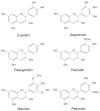The Anti-inflammatory Effects of Dietary Anthocyanins against Ulcerative Colitis
- PMID: 31137777
- PMCID: PMC6567294
- DOI: 10.3390/ijms20102588
The Anti-inflammatory Effects of Dietary Anthocyanins against Ulcerative Colitis
Abstract
Ulcerative colitis (UC), which is a major form of inflammatory bowel disease (IBD), is a chronic relapsing disorder of the gastrointestinal tract affecting millions of people worldwide. Alternative natural therapies, including dietary changes, are being investigated to manage or treat UC since current treatment options have serious negative side effects. There is growing evidence from animal studies and human clinical trials that diets rich in anthocyanins, which are pigments in fruits and vegetables, protect against inflammation and increased gut permeability as well as improve colon health through their ability to alter bacterial metabolism and the microbial milieu within the intestines. In this review, the structure and bioactivity of anthocyanins, the role of inflammation and gut bacterial dysbiosis in UC pathogenesis, and their regulation by the dietary anthocyanins are discussed, which suggests the feasibility of dietary strategies for UC mitigation.
Keywords: anthocyanins; anti-inflammatory; colitis; colonic inflammation.
Conflict of interest statement
The authors declare no conflict of interest.
Figures



References
-
- Andersen O.M., Markham K.R. Flavonoids: Chemistry, biochemistry and applications. CRC Press; Boca Raton, FL, USA: 2005.
-
- Borges G.D.S.C., Vieira F.G.K., Copetti C., Gonzaga L.V., Zambiazi R.C., Mancini Filho J., Fett R. Chemical characterization, bioactive compounds, and antioxidant capacity of jussara (euterpe edulis) fruit from the atlantic forest in southern brazil. Food Res. Int. 2011;44:2128–2133. doi: 10.1016/j.foodres.2010.12.006. - DOI
Publication types
MeSH terms
Substances
Grants and funding
LinkOut - more resources
Full Text Sources
Medical

